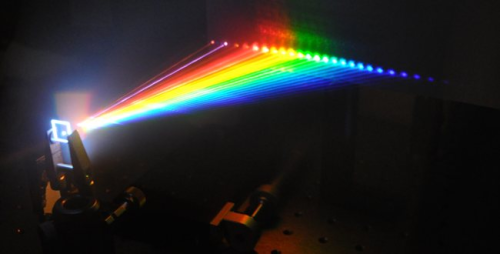Hey, how about that! Three people in our optics group here at Texas A&M (Professor Alexei Sokolov, postdoc Miaochan Zhi, and grad student Kai Wang) had a photograph from one of their optics experiments make the Optics and Photonics News Image of the Week:
The crystal in the foreground is being hit by two pulses of light, which interact with the material and each other in such a way as to form numerous other beams with different wavelengths, forming the rainbow of discrete beams seen in the photograph.
This is an effect which bears the acronym CARS - Coherent Anti-Stokes Raman Spectroscopy. Roughly, the crystal is composed of a bunch of molecules which can be modeled as atoms connected together by elastic bonds. Whack these molecules very hard with an intense laser pulse, and the molecules will start vibrating in much the same say as a lump of Jell-O would if you poked it. Send a second pulse through those vibrating molecules and it will be scatter off that vibration and either transfer some energy to the vibration (Stokes scattering) or gain some energy from the vibration (anti-Stokes scattering).
Ok, but why do we get discrete beams, and why do they come out at different angles? There's two principles at work here. The first is conservation of energy. The energy of the incoming photon, plus (or minus) the energy removed from (or added to) the vibration, is the energy of the outgoing photon. The energy of a molecular vibration is quantized - molecules can't vibrate with just any amount of energy. Thus $latex \Delta E$ can't vary continuously but can only take quantized values (Maybe something like 0.1 eV, 0.2 eV, 0.3 eV..., though it's never that neat and clean.).
The second principle is conservation of momentum. The incoming light from the two lasers introduce photons with their own momenta, and the outgoing photons have momentum as well. Conservation of momentum implies that the incoming photons have the same total momentum as the outgoing photons. The momentum of a photon is $latex p = h/\lambda$, so the outgoing photons of different colors have different momenta. This means each color can only satisfy the energy and momentum conservation requirements simultaneously for one specific angle which is unique to the wavelength.
There's a tremendous amount of interesting physics that you can do with CARS and related techniques. But it's nice when the physics is also photogenic.
